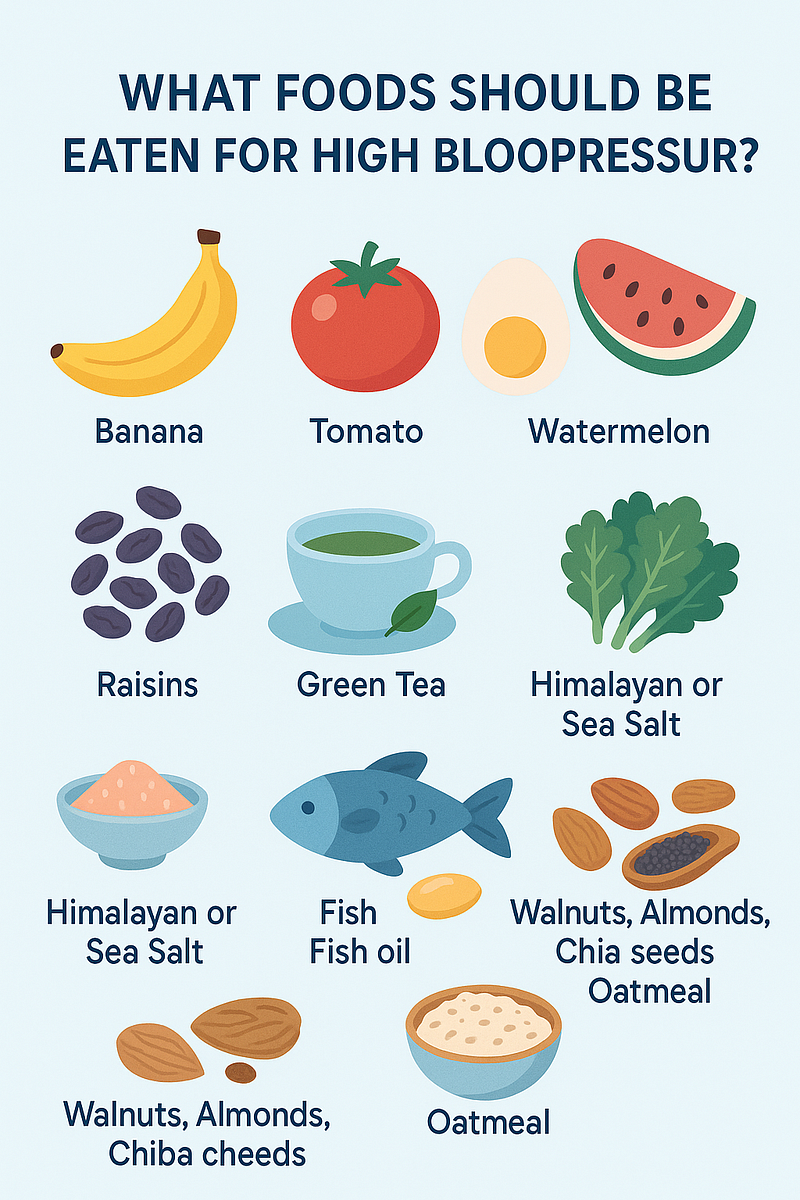What foods should be eaten for high blood pressure?

What should be done if high blood pressure becomes an inevitable issue with increasing age?
The first step is to undergo a medical examination, get the necessary medication prescribed, and also consult a qualified nutritionist for dietary therapy. However, before that, it is important to understand what blood pressure is.
When our heart beats, it circulates blood throughout the body, providing it with the required energy and oxygen. During this circulation, pressure is exerted on the walls of the blood vessels. Whether this pressure is low or high — this is what defines blood pressure.
The only way to know it is to measure it.
When blood pressure (BP) is measured, it is written in two numbers — for example, 120/80 mm Hg, or 120 over 80. This is considered normal blood pressure. What is High Blood Pressure?
If your lower blood pressure reading is 90 and the upper is 140 or more, and this condition persists for several days, you may have high blood pressure. Even if only one of the two readings is high, it can still indicate high blood pressure.
We often don’t feel sick due to high blood pressure, but it is dangerous. If not managed, it can damage the heart, blood vessels, and other organs, leading to serious complications.
What Diet is Better for High Blood Pressure?
In reality, our diet often becomes our enemy — because out of carelessness, we continue to consume foods that are harmful to our health. The first and most common advice for managing high blood pressure is to reduce salt intake.
Generally, patients with high blood pressure are fond of salty foods and even raw salt. But if you want to prevent high blood pressure, salt must be almost eliminated from your diet.
Below are some foods that help counteract the effects of salt:
1. Banana
Excess sodium (salt) raises blood pressure, and potassium — found abundantly in bananas — helps to counteract it.
According to a study, consuming just 2 bananas a day can lower blood pressure by up to 10%.
2. Tomato
Tomatoes contain carotenoid, a compound that helps lower blood pressure.
Adding raw salad to your daily meals can significantly reduce bad cholesterol.
Steam tomatoes and eat them (with seeds if kidneys are healthy, or without if not), and you’ll feel better.
3. Egg White
Starting your day with a healthy breakfast is essential.
The body needs protein in the morning. While recent studies don’t label the yolk as harmful, at least one egg white is highly recommended.
4. Watermelon
In summer, eating a small amount of watermelon on an empty stomach daily is beneficial.
It helps regulate blood circulation and maintains normal blood pressure.
Watermelon juice (without added sugar) can be used, but the pulp is rich in fibre — so eating the fruit is preferable.
5. Raisins
Dried fruits can be eaten year-round in moderation.
Even a small amount of raisins can help control blood pressure.
In summer, add some raisins to sweet dishes like rice pudding or sweet yellow rice for a more nutritious lifestyle.
6. Green Tea
Unless we change our lifestyle, health issues will persist.
Reduce intake of regular tea and coffee and make green tea a daily habit.
Drinking 3 cups of green tea daily for 6 weeks can reduce blood pressure by up to 7 points.
7. Dark Green Vegetables
Red meat (beef, lamb, etc.) and poultry can be harmful for high BP.
If you must eat meat, reduce the quantity and ensure that half your plate is filled with vegetables at every meal.
Dark green vegetables are rich in essential minerals like magnesium and iron.
Cooking them with ginger and garlic enhances their benefits.
8. Himalayan or Sea Salt instead of Table Salt
Common table salt contains only two minerals — sodium and chloride.
Himalayan and sea salts have over 70 minerals essential for nerve and heart health, and they contain much less sodium.
Excess sodium causes water retention in the body, which increases blood volume and pressure.
9. Fish and Fish Oil Supplements
Both are helpful in reducing blood pressure, heart diseases, and other chronic conditions.
10. Walnuts, Almonds, Chia Seeds, and Oatmeal
Mix pine nuts or walnuts into oatmeal — it helps control blood pressure.
Chia seeds are used in drinks and help regulate circulation in addition to cooling the body.
Soak a few seeds in clean water until they swell, then mix them with a red syrup drink. This is very effective in summer due to its cooling nature.
Bonus Tip: Breathing Exercise
Spending 10 to 15 minutes daily in fresh air doing deep breathing can help normalise blood pressure.
Note: Breathe about 6 times per minute.
Shallow breathing causes sodium retention, while deep, slow breathing increases oxygen supply.
Regular exercise, stress control, and blood pressure monitoring are essential parts of effective management.

0 Comments